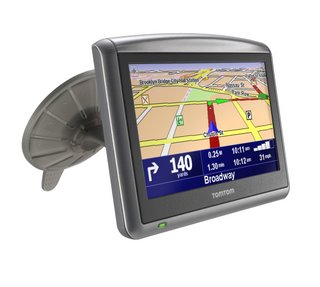
Dear GPS buffs,
Feeling stressed at the wheel? A little ? A lot ? Sometimes to the point of cracking because you’re going the wrong way ? Maybe you’ve lost sight of road signs or you just don’t understand what the signs mean because you’re in a foreign country.
When your patience has reached its maximum, you take that frustration out on your passenger who just happens to be your boyfriend/girlfriend/wife/husband/partner. They desperatly turn the map every which way, trying to find the best solution. And if there are children in the car and they ask that dreaded question, “are we there yet?”, after barely half an hour of driving, it’s not hard to imagine how the atmosphere in the car could easily reach a boiling point.
I was recently thinking about how difficult it can be to remain focused and calm in traveling situations. This became clear to me on my recent trip to the US, during which we were equipped with a GPS (TomTom, model ONE).
- It is held in place by simple suction cup and plugged into the lighter. We stuck it under the rearview mirror, a little to the side to make sure it didn’t distract the driver.
- Once the information is entered into the system, the car becomes an arrow on the screen.
- The distance traveled, how many kilometers left to go, and the time estimated of arrival is always indicated so you’ll be able to answer that pesky question, “How much longer?”, very quickly 😉
- In case of driver error, your position will automatically be re-calculated and the GPS will adapt its route according to where you are.
- Find the closest parking or gas station in just three or four easy steps by using the touch screen. It’s better not to do this while driving?
- Activate or deactivate the voice option (female or male voice with translations in two or three languages). This way you don’t have to constantly check the screen and you can concentrate on driving and keeping an eye out for external dangers (other cars, bikes, traffic lights, road signs, etc.). Using it can also be intrusive if you’re listening to music or if you just don’t feel like having someone pipe up every time you turn onto a new street.
- Get software updates on their Internet site. You can also save your favourite routes and refer to them before you leave.
There are however, some weaknesses in three of the design elements:
1. anticipation ;
2. tracking ;
3. margin of error ;
Anticipation: When there’s a turn coming up, the system only tells you the distance left before you have to turn. It doesn’t tell you, for example, if it’s the second or third street on your left or right. This could lead to mistakes, especially if it’s a street where you can’t turn (as once was the case).
Tracking: The tracking function is not always reliable because the signal can get lost, for example, when driving downtown on narrow streets surrounded by tall buildings.
Margin of error: There is a 150m gap between what you see on the road and what is posted on the screen. You must keep this in mind at all times.
How will the GPS improve the stormy family atmosphere described at the beginning of this blog?
• Less time wasted on the road when getting lost
• Less stress and a more relaxed atmosphere
• Navigation control at all times and, if ever the system has any problems with its tracking function, you can always fall back on the tried-and-true technique of putting the window down and asking for directions.
Back in the day, there was a car, a couple and a destination. That hasn’t changed. However, now that the GPS is here, stress-levels have gone down and maps havce been relegated to the glove compartment, just in case.
Photo : TomTom
0 Comment(s)